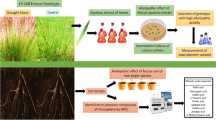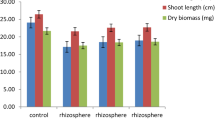Abstract
Populations of Stellera chamaejasme L. have been increasing constantly in recent years in some areas of the grassland in north China but why this toxic weed has become highly competitive is not clear. In order to determine if any potential allelochemicals are released into the soil environment by S. chamaejasme, we investigated the chemical composition of a water-washed solution of the living roots with rhizosphere soil. This led to the isolation and identification of seven compounds: umbelliferone (1), daphnoretin (2), chamaechromone (3), 7-methoxyneochamaejasmine A (4), mesoneochamaejasmin A (5), neochamaejasmin B (6), dihydrodaphnodorin B (7). All are secondary metabolites of S. chamaejasme. Bioassay showed that 1, 5 and 6 had a strong inhibitory effect on Festuca rubra L. and Medicago sativa seedlings. These compounds were quantified by high performance liquid chromatography in 25 root zone soil samples of S. chamaejasme collected at altitudes between 165 and 4741 m from the northeast to the Tibetan Plateau of China. All samples contained at least one of the phytotoxic compounds. Their content did not correlate with the altitude of the growing site. However, the level of chamaechromone negatively correlated with the soil pH. Principle components analysis indicated that the flavonoids might come from the same source. These potential allelochemicals from root release into the soil might play an important role in the highly competitive nature and broad ecological adaptability of S. chamaejasme in the wild.





Similar content being viewed by others
References
Anaya AL, Ortega RC, Rodriguez VN (1992) Impact of allelopathy in the traditional management of agroecosystem in Mexico. In: Rizvi SJH, Rizvi V (eds) Allelopathy. Basic and applied aspects. Chapman & Hall, London, pp 272–301
Blanco JA (2007) The representation of allelopathy in ecosystem-level forest models. Ecol Model 209:65–77
Cao CY, Fu Y, Wang WX, Gao FF (2007) Inhibition influence of extraction liquids from Stellera chamaejasme root on seed germination. J Northeast Univ 28:729–732
Chou CH, Young CC (1974) Effects of osmotic concentration and pH on plant growth. Taiwania 19:157–165
Djordjevic MA, Redmond JW, Batley M, Rolfe BG (1987) Clovers secrete specific phenolic compounds which either stimulate or repress nod gene expression in Rhizobium trifolii. EMBO J 6:1173–1179
Feng BM (2002) Research on the anti-epilepsy constituents of Stellera chamaejasme L. and Citrus grandis Osbeek. Dissertation, Shenyang Pharmaeeutical University
Feng BM, Pei YH, Han B (2001) Flavonoids from root of Stellera chamaejasme. Chin Tradit Herb Drugs 32:14–15
Fischer NH, Williamson GB, Weidenhamer D, Richardson DR (1994) In search of allelopathy in the Florida scrub: the role of terpenoids. J Chem Ecol 20:1355–1380
Grey WC (1995) Stellera chamaejasme: an overview. New Plantsman 2:43–49
Hao WY, Ren LX, Ran W, Shen QR (2010) Allelopathic effects of root exudates from watermelon and rice plants on Fusarium oxysporum f.sp. niveum. Plant Soil 336:485–497
Jiang ZH, Tanaka T, Sakamoto T, Kouno I, Duan JA, Zhou RH (2002) Biflavanones, diterpenes, and coumarins from the roots of Stellera chamaejasme L. Chem Pharm Bull 50:137–139
Kato-Noguchi H, Fushimi Y, Kimura F, Morita M, Suenaga K (2012) Organ-specific-active allelopathic substance in red pine needles. Plant Growth Regul 68:171–175
Kobayashi K (2004) Factors affecting phytotoxic activity of allelochemicals in soil. Weed Biol Manag 4:1–7
Kong C, Xu T, Hu F, Huang S (1999) Allelopathy under environmental stress and its induced mechanism. Acta Ecologica Sinica 20:849–854
Kong CH, Wang P, Gu Y, Xu XH, Wang ML (2008) Fate and impact on microorganisms of rice allelochemicals in paddy soil. J Agric Food Chem 56:5043–5049
Liu GF, Zhao CL, Hou FF, Yang SS, Zhao TL, Liu QG (1996) Studies on the chemical constituents of chinese stellera(Stellera chamaejasme) (I). Chin Tradit Herb Drugs 27:67–79
Liu Y, Long R, Yao T (2004) Research progress on Stellera chamajasme L. in grassland. Pratacult Sci 21:55–61
Mahmood K, Khan MB, Ijaz M, Zeng RS, Luo SM (2014) Molecular, biochemical and bioassay based evidence of lower allelopathic potential in genetically modified rice. Plant Growth Regul 74:73–82
Mishra S, Nautiyal CS (2012) Reducing the allelopathic effect of Parthenium hysterophorus L. on wheat (Triticum aestivum L.) by Pseudomonas putida. Plant Growth Regul 66:155–165
Narantuya S, Batsurén D, Rashkes YV, Mil’grom EG (1994) Chemical study of plants of the Mongolian flora coumarins of Stellera chamaejasme: the structure of chamaejasmoside—a new bicoumarin glycoside. Chem Nat Compd 30:197–199
Niwa M, Tatematsu S, Liu GQ, Hirata Y (1984) Isolation and structures of two new C-3/C-3″-biflavanones, neochamaejasmin a and neochamaejasmin B. Chem Lett 13:539–542
Paul GD, Miller AJ, Hirsch PR (2010) Are root exudates more important than other sources of rhizodeposits in structuring rhizosphere bacterial communities? FEMS Microbiol Ecol 72:313–327
Queiroz SCN, Cantrell CL, Duke SO, Wedge DE, Nandula VK, Moraes RM, Cerdeira AL (2012) Bioassay-directed isolation and identification of phytotoxic and fungitoxic acetylenes from Conyza canadensis. J Agric Food Chem 60:5893–5898
Quintana N, Weir TL, Du J, Broeckling CD, Rieder JP, Stermitz FR, Vivanco JM (2008) Phytotoxic polyacetylenes from roots of Russian knapweed (Acroptilon repens (L.) DC.). Phytochemistry 69:2572–2578
Reigosa MJ, Sánchez-Moreiras A, González L (1999) Ecophysiological approach in allelopathy. Crit Rev Plant Sci 18:577–608
Seyed MR (2011) Plant coumarins as allelopathic agents. Int J Biol Chem 5:86–90
Sosa T, Valares C, Alías JC, Lobón NC (2010) Persistence of flavonoids in Cistus ladanifer soils. Plant Soil 337:51–63
Sun G, Luo P, Wu N, Qiu PF, Gao YH, Chen H, Shi FS (2009) Stellera chamaejasme L. increases soil N availability, turnover rates and microbial biomass in an alpine meadow ecosystem on the eastern Tibetan Plateau of China. Soil Biol Biochem 41:86–91
Taniguchi M, Fujiwara A, Baba K (1997) Three flavonoids from Daphneodora. Phytochemistry 45:183–188
Taylor LP, Grotewold E (2005) Flavonoids as developmental regulators. Curr Opin Plant Biol 8:317–323
Tharayil N, Bhowmik PC, Xing B (2008) Bioavailability of allelochemicals as affected by companion compounds in soil matrices. J Agric Food Chem 56:3706–3713
Treutter D (2006) Significance of flavonoids in plant resistance: a review. Environ Chem Lett 4:147–157
Wang Y, Gilbert MG (2007) Flora of China. Science Press, Beijing
Yang GH (2005) Bioactive Constituents of Stellera chamaejasme, Zanthoxylum nitidum and Geranium strictipes. Dissertation, University of Fudan
Yaoya S, Kanho H, Mikami Y, Itani T, Umehara K, Kuroyanagi M (2004) Umbelliferone released from hairy root cultures of Pharbitis nil treated with copper sulfate and its subsequent glucosylation. Biosci Biotech Biochem 68:1837–1841
Zhang YH, Volis S, Sun H (2010) Chloroplast phylogeny and phylogeography of Stellera chamaejasme. Mol Phylogenet Evol 57:1162–1172
Zhang ZQ, Zhang YH, Sun H (2011) The reproductive biology of Stellera chamaejasme (Thymelaeaceae): a self-incompatible weed with specialized flowers. Flora 206:567–574
Zhao L, Lou ZY, Zhu ZY, Zhang GQ, Chai YF (2008) Characterization of constituents in Stellera chamaejasme L. by rapid-resolution liquid chromatography–diode array detection and electrospray ionization time-of-flight mass spectrometry. Biomed Chromatogr 22:64–72
Zhao BY, Liu ZY, Lu H (2010) Damage and control of poisonous weeds in Western Grassland of China. Agric Sci China 9:1512–1521
Zhou SQ, Wang H, Huang ZJ, Liu YL, Hu HF (2008) Research on allelopathy of Steura chamaejasme in decompose process in the soil on Alfalfa. Chin J Grassland 30:78–92
Acknowledgments
We thank Professor Frank Stermitz for editorial assistance. This work was financially supported by the National Natural Science Foundation of China (31070386), Basic Research Program of Lanzhou Institute of Chemical Physics, Chinese Academy of Sciences (080423SYR1), the ‘Western Light’ associate scholar talent cultivation program of the Chinese Academy of Sciences, the Province-academy Cooperation Program of Henan Province of China (NO. 102106000021) and the ‘One-Three-Five’ Strategic Planning of Lanzhou Institute of Chemical Physics, Chinese Academy of Sciences.
Author information
Authors and Affiliations
Corresponding author
Electronic supplementary material
Below is the link to the electronic supplementary material.
Rights and permissions
About this article
Cite this article
Guo, H., Cui, H., Jin, H. et al. Potential allelochemicals in root zone soils of Stellera chamaejasme L. and variations at different geographical growing sites. Plant Growth Regul 77, 335–342 (2015). https://doi.org/10.1007/s10725-015-0068-4
Received:
Accepted:
Published:
Issue Date:
DOI: https://doi.org/10.1007/s10725-015-0068-4




